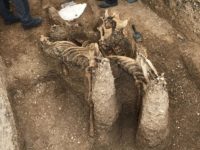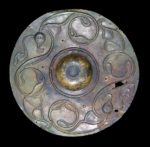 The unique chariot burial unearthed at Pocklington, East Yorkshire, in 2018 has proven even more extraordinary than it first seemed, and that’s saying a lot. This was the second chariot burial discovered at the site of a new housing development. That’s two of only 27 ever discovered in the UK, both found in a single Iron Age burial ground within a year of each other. Then, in contrast with the previously-discovered chariot burial, this one featured a chariot yolked to two ponies and buried upright, only decapitated after the grave had been filled high enough to keep them in place so they would be forever captured as in motion. No other upright chariot burials like have been found in the UK. Inside the chariot, face-down, was a bronze shield. The deceased was placed on top of it.
The unique chariot burial unearthed at Pocklington, East Yorkshire, in 2018 has proven even more extraordinary than it first seemed, and that’s saying a lot. This was the second chariot burial discovered at the site of a new housing development. That’s two of only 27 ever discovered in the UK, both found in a single Iron Age burial ground within a year of each other. Then, in contrast with the previously-discovered chariot burial, this one featured a chariot yolked to two ponies and buried upright, only decapitated after the grave had been filled high enough to keep them in place so they would be forever captured as in motion. No other upright chariot burials like have been found in the UK. Inside the chariot, face-down, was a bronze shield. The deceased was placed on top of it.
When the find was first announced, the upright burial got the lion’s share of the attention. Now that the shield has been cleaned and conserved, it is stepping into limelight as a masterpiece of Celtic art.
Specialist conservation has revealed a swirling La Tène style architecture, typical of early Celtic art, said Paula Ware, from MAP Archaeological Practice who carried out an excavation on behalf of Persimmon Homes.
She said the repousse design, made by hammering the bronze sheet from the underside, featured evidence of organic forms, such as spiralling mollusc shells creating a three-legged triskele motif, and the highly decorative asymmetrical design drew the eye to a central raised boss. […]
“The shield features a scalloped border. This previously unknown design feature is not comparable to any other Iron Age finds across Europe, adding to its valuable uniqueness.
“The popular belief is that elaborate metal-faced shields were purely ceremonial, reflecting status, but not used in battle. Our investigation challenges this with the evidence of a puncture wound in the shield typical of a sword. Signs of repairs can also be seen, suggesting the shield was not only old but likely to have been well-used,” said Paula.
 Its spiral motifs in the early Celtic La Tène style are similar to those found on the Wandsworth shield boss, recovered during dredging operations on the Thames some time before 1849 and donated to the British Museum in 1858.
Its spiral motifs in the early Celtic La Tène style are similar to those found on the Wandsworth shield boss, recovered during dredging operations on the Thames some time before 1849 and donated to the British Museum in 1858.
Persimmon Homes Yorkshire, the housing developers who own the property and the archaeological finds (non of them qualify as official treasure despite their age and immense significance because they are not made of precious metal) plan to donate them to a local museum yet to be determined.
